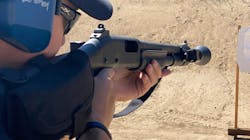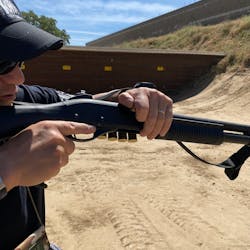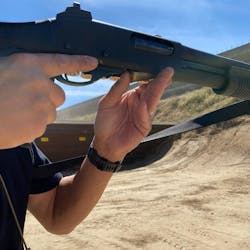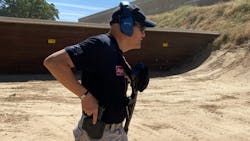Shotguns for Law Enforcement
Why a shotgun?
The shotgun is one of several lethal choices available to law enforcement. It is a deliberate deployment firearm, meaning it is not something that one uses primarily, unless some circumstance prompts the shotgun to be employed. Even though many agencies equip officers with carbines, the shotgun is superior in close-quarters use, and guns equipped with slugs can deliver accurate fire in the 100-yard range. A properly equipped officer can cloverleaf slugs at 50 yards with a minimal amount of training. I have consistently practiced with my 870 at 150 yards, with which I can land slugs in a 4-inch circle. This is the least expensive strategy for an agency who equips officers with long guns.
The shotgun is the most flexible tool in the locker; capable of less-lethal payload delivery, defeating locks, dispatching dangerous game and close-quarters entry. Bear in mind, however, that agencies should always use dedicated shotguns that are well marked.
Most law enforcement agencies deploy either slugs or buckshot, or a combination of both. The munitions have improved. There are several slug products that are rifled, designed to increase the accuracy of smoothbore barrels. For example, the Federal TruBall Rifled Slug throws a one ounce slug at 1600 feet per second, and can deliver two-inch groups at 50 yards.
Our tests have demonstrated that there is a myth that shotguns over-penetrate less than AR-15 style carbines in building materials, and are therefore safer in urban settings. Actually, both carbines and shotguns over penetrate much further than most people anticipate, making training in both shooting and decision-making skills critical components in firearms deployment.What kind of shotgun?
First, police agencies use shotguns because they are simple, flexible, very effective, and inexpensive to purchase, operate and maintain.
I use a Remington 870 for a lot of reasons, but foremost is the fact that I can work on them in my sleep. There are plenty of good, inexpensive, shotgun products out there. When I contacted range instructors from different agencies, I found that most either use a Remington 870 variant, or a Mossberg 590 (or 500 Tactical) variant. There are several models mentioned, but my poll was informal, at best. Years ago, I asked department rangemasters about which shotguns they used, and use was about the same. Coincidentally, my range instructor friends who had U.S. Marine training tended towards the Mossberg variants. Most others gravitated towards Remington. I have both, and both are equally indestructible, and equally simple.
Left-handed shooters often gravitate toward Mossberg products. The safety is on the top of the receiver, instead of near the trigger guard.If the agency wishes to go to mini shells, which are popular right now because they nearly double the capacity of a shotgun, the choice is a Mossberg, equipped with an inexpensive OpSol Mini Clip (opsolmini-clip.com). Using this set up, my Mossberg 590 Tactical holds 17 rounds in the magazine alone.
My personal Remington 870 is set up almost exactly as I had it in a Big Sky rack in my patrol car. The accessories mentioned here are serious updates, but I’m telling you this for a specific reason: When I responded with my 70 caliber instrument, I had 23 rounds on the gun, or 28.75 ounces of peacekeeping projectiles, without carrying additional tools.
Most agencies find that the utility, and inherent safety of the pump shotgun serves them well. I find that the pump gun gives the user a little extra leverage for extraction. However, if we were to look at typical tactical guns like the Benelli M4, there is no difference in reliability between the two. Some auto guns will not shoot specialty shells without adjustment, but specialty shells should always be used in designated guns anyway.
Auto guns cycle faster. Pump guns have a little more flexibility.I do like autos, and the Remington V3 Tactical has one of the smoothest actions for police work. I’d pick it for its oversized charging handle and reliable gas system. The Benelli M4 variants, with their Auto-Regulating Gas-Operated (A.R.G.O.) system has already proven to be flexible and robust. Both of these guns are winners in target rich environments.
XS Sights Remington 870 +2 Magazine Extension Kit
I like to have at least a couple more rounds in my magazine than the standard 4. About the time I started to put this article together, I got a hold of the new XS Sights magazine extension. It is made of anodized 6061 aluminum, and comes with a 45-inch Wolff extended 12-gauge magazine spring. It also comes with a detent swage tool, which smoothly removes the detent used to hold the magazine spring in a standard magazine installation. This extension is a little thicker than similar products, and it has wrench flats, which also add to the appearance of the tube.
There are video instructions for the amateur armorer, but the installation is simple, and I was up and running in minutes.
Why did I opt for the XS Sights Magazine Extension? I was trying to get rid of the extension I had on my gun. Every once in a while, it hiccupped, and sometimes I couldn’t get the last round in. The XS Sights Magazine Extension is smoother inside, and it fit together on my Remington better. The balance and smoothness improved. I don’t leave anything to chance, and you shouldn’t either.
Mesa Tactical
Most of my shotgun is outfitted with Mesa Tactical products. It has an Urbino Pistol Grip Stock. It has a SureShell Polymer Carrier, the only adjustable shotshell carrier on the market, and a Mesa Tactical Magazine Clamp with Rail kit.
The Urbino Pistol Grip Stock is the way to go when a low profile sling mount (Benelli style) is desired. The stock is made from glass filled polymer, and features a Limbsaver butt pad. It is shorter than standard length stocks, allowing for full coverage armor, without making it uncomfortable when training on the range out of uniform.
The sling connects at the front using a quick release mount that plugs into the Mesa Tactical Magazine Clamp with Rail. This is a dual tube clamp that fit exactly between the raised parts of my XS Sights magazine extension.What should I work on?
There are simple perishable shotgun skills that every officer needs to acquire. There’s not a lot to them, but every user should know them, hands down.
Transition
Law enforcement officers need to be able to transition smoothly from the handgun to the shotgun, and back to the handgun. I use a two-point adjustable sling, which has a strap that allows me to cinch it close to the chest, muzzle down. Blue Force Gear carries the Vickers Sling, which is ideal for this application. It has a pull tab that allows adjustments on the fly, and users can get it quickly out of the way.
With a pump, one can cycle the slide to the rear after firing, and leave the chamber open. The other option is simply flicking the safety on. Either way, the officer must render the gun safe before letting it drop on the weight of the sling. If the gun is slung over the firing shoulder, it can simply be slid out of the way, opening the opportunity to draw the handgun. This is where I like this style of sling. If there is time, I cinch it close to the chest.
This is a simple skill, but without it, there is no handcuffing, moving in close quarters, or overcoming obstacles. Learn to switch back and forth. Include simple things like movement from target group to target group, barricaded shooting, and changing shooting positions. If this practice does not require knee pads, you’re doing it wrong.
Loading
This is another simple skill, but the habits we develop incorrectly can prove to be embarrassing, and sometimes fatal.
Learn to load the gun while it is still on the shoulder, aimed at the threat. In order to do this, officers need to find the sweet spot on how to arrange the shells on the carrier, and how to extract them with economy. I put the same type of shells on my carrier, primer side down, except the furthest forward one, which goes primer side up. I load by placing my support hand thumb on the primer.
The last shell is for loading into an open chamber, as the first round of an empty magazine. The gun stays on the shoulder. The shell goes into the support hand with the fingers slightly curled around it. The support hand pops it out of the carrier, then the Officer rotates the gun about a one-fourth turn so the support hand is holding the oriented shotshell over an empty chamber. It is dropped in, and the shotgun is rotated back into firing position, while the officer runs the slide forward. If done correctly, the shell comes from the carrier and goes into the chamber, moving no more than an inch.
If you have ever seen 3-gun shooters, they load with their guns inverted, two or more shells at a time. We like to keep our guns pointed at the threat, so it may be a little slower. However, if 3-gun is your game and you can toss shells into a 940 JM Pro magazine as quickly as Jerry Miculek, you don’t need any help from me.
Unloading
I know it sounds silly, but some law enforcement users unload their shotguns by pumping the slide. This is unacceptable. Learn to unload the shotgun by manipulating the magazine stops.
There you have it. Every tool in the locker has its place, and the law enforcement shotgun will continue to serve.

Officer Lindsey Bertomen (ret.), Contributing Editor
Lindsey Bertomen is a retired police officer and retired military small arms trainer. He teaches criminal justice at Hartnell College in Salinas, California, where serves as a POST administrator and firearms instructor. He also teaches civilian firearms classes, enjoys fly fishing, martial arts, and mountain biking. His articles have appeared in print and online for over two decades.








